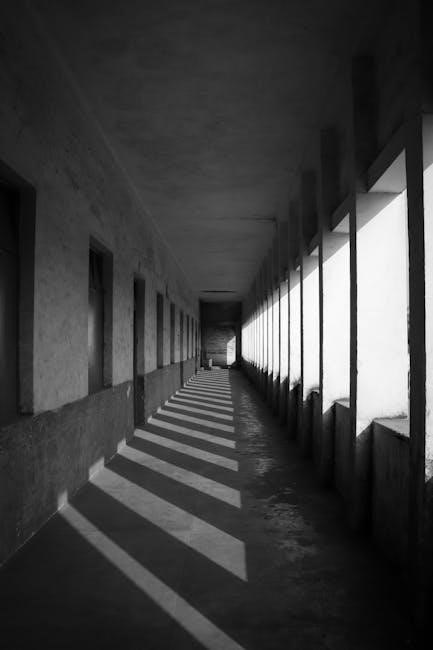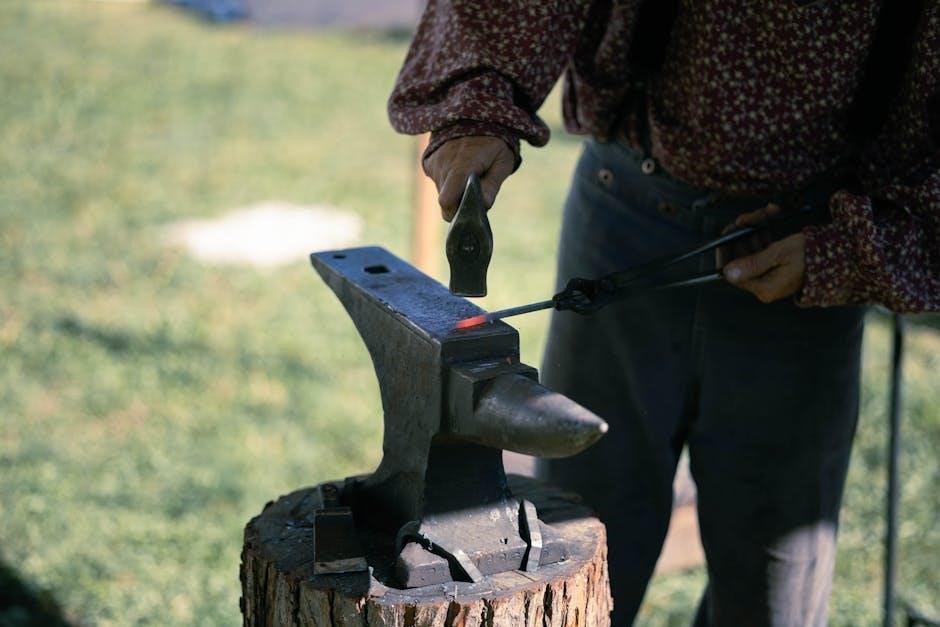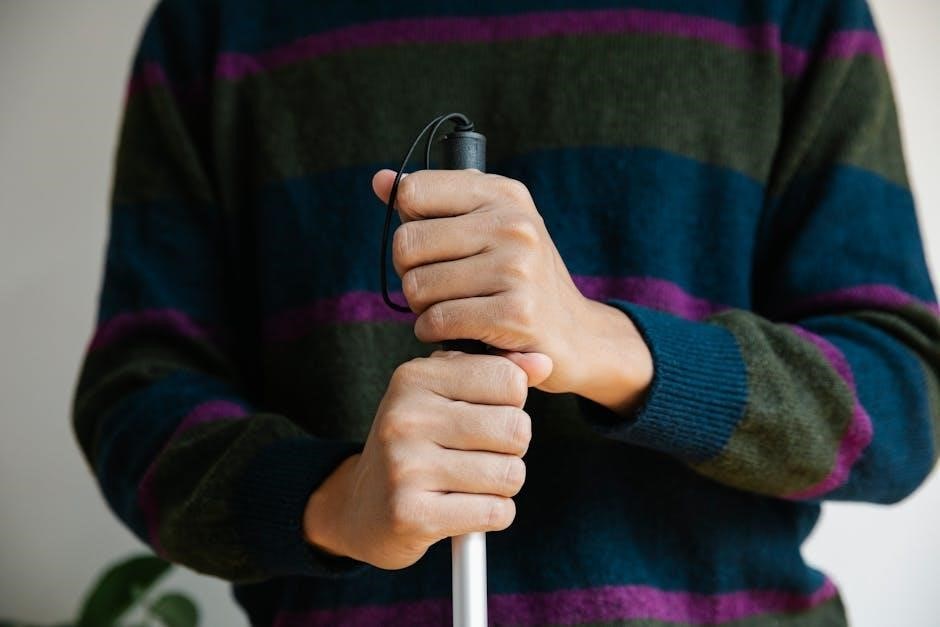Polypipe Underfloor Heating offers a modern, energy-efficient solution for home heating, providing comfort and reliability. This guide helps users understand and install the system effectively.
1.1 What is Underfloor Heating?
Underfloor heating is a modern heating system that circulates warm water through pipes installed beneath the floor. It provides radiant heat, warming rooms evenly from the ground up. Unlike traditional radiators, underfloor heating eliminates the need for wall-mounted units, creating more space and aesthetic freedom. The system operates at lower temperatures than conventional heating, making it energy-efficient and cost-effective. It can be powered by various heat sources, including boilers, heat pumps, or solar panels, offering flexibility for different energy needs. Underfloor heating is ideal for new constructions and renovations, providing consistent comfort and improved indoor air quality by reducing dust circulation. This guide focuses on Polypipe systems, known for their reliability and innovative design, helping users achieve efficient and cozy heating solutions.
1.2 Benefits of Polypipe Underfloor Heating
Polypipe Underfloor Heating offers numerous advantages, including energy efficiency, lower energy bills, and consistent warmth. It eliminates the need for radiators, freeing up wall space and enhancing interior design. The system operates at lower temperatures than traditional heating, reducing energy consumption while maintaining comfort. It is compatible with various heat sources, such as heat pumps, making it eco-friendly. Polypipe systems are durable, reliable, and require minimal maintenance. They also provide better air quality by reducing dust circulation. The even heat distribution ensures a cozy environment, and the flexibility in design allows customization for different room layouts. Overall, Polypipe Underfloor Heating is a modern, efficient, and cost-effective solution for home heating needs.
1.3 Scope of This User Guide

This user guide provides a comprehensive overview of Polypipe Underfloor Heating systems, covering installation, operation, and maintenance. It is designed for homeowners, installers, and professionals to understand the system’s components, benefits, and best practices. The guide includes detailed sections on planning, design considerations, and troubleshooting, ensuring a smooth and efficient setup. It also emphasizes safety precautions and maintenance tips to prolong system lifespan. While the guide is thorough, it is recommended to consult professionals for complex installations or specific technical queries. This resource aims to empower users with the knowledge needed to maximize the performance and efficiency of their Polypipe Underfloor Heating system, ensuring optimal comfort and energy savings.
Components of the Polypipe Underfloor Heating System
The system includes underfloor heating pipes, manifolds, thermostats, pumps, and insulation materials, all designed to work seamlessly for efficient and reliable heating solutions.
2.1 Overview of the System
The Polypipe Underfloor Heating System is a comprehensive solution designed to provide efficient and consistent heat distribution across various spaces. It operates by circulating warm water through a network of pipes installed beneath the floor, ensuring even heat distribution. The system is highly adaptable, suitable for both new constructions and renovations, and can be integrated with a variety of heat sources, including boilers, heat pumps, and solar systems. Its design emphasizes energy efficiency, reducing energy consumption compared to traditional radiators. The system is controlled by advanced thermostats and manifolds, allowing precise temperature regulation. This overview highlights the core functionality and versatility of the Polypipe Underfloor Heating System, making it a reliable choice for modern heating needs.

2.2 Key Components and Accessories
The Polypipe Underfloor Heating System consists of several essential components and accessories that ensure optimal performance. The primary elements include the underfloor heating pipes, which are durable and designed for long-term use. Manifolds are central to the system, acting as distribution points for the heated water; Thermostats and temperature sensors are crucial for precise temperature control, while heat sources such as boilers or heat pumps provide the energy needed. Accessories like pipe fittings, insulation materials, and control systems enhance the system’s efficiency. Additionally, circulation pumps and mixing valves are included to regulate water flow and temperature. These components work together seamlessly to deliver a reliable and energy-efficient heating solution. Using genuine Polypipe accessories ensures compatibility and maintains the system’s performance and warranty.
Planning and Design Considerations
Planning and design are crucial for an efficient underfloor heating system. Assess your space, design the layout, and select materials to ensure optimal performance and energy efficiency.
3.1 Assessing Your Heating Needs
Assessing your heating needs is the first step in designing an efficient underfloor heating system. Evaluate the size of your property, insulation quality, window types, and existing heating systems. Consider the usage of each room and your personal comfort preferences. Identify areas that require more heat, such as living spaces, and those that may need less, like bathrooms. Factor in the building’s age, construction type, and local climate to determine heat loss. This assessment will help you create a tailored heating plan, ensuring optimal performance and energy efficiency. A detailed room-by-room analysis is essential to match your lifestyle and heating requirements accurately. This step ensures your system is appropriately sized and configured for maximum comfort and cost-effectiveness.

3.2 Designing the Layout of Your Underfloor Heating
Designing the layout of your underfloor heating system requires careful planning to ensure even heat distribution and maximum efficiency. Start by mapping the room dimensions and identifying heat sources, such as radiators or heat pumps. Consider furniture placement and fixed features like kitchen islands or staircases to avoid obstructing pipe runs. Divide the space into zones if necessary, especially in larger areas, to allow independent temperature control. Use a manifold to distribute water evenly across the system. Ensure pipes are spaced correctly, typically 150-300mm apart, depending on the desired heat output. Avoid placing pipes under fixed furniture or near exterior walls to minimize heat loss. Finally, consult a professional or use specialized software to validate your design and ensure it meets your heating needs effectively.
3.3 Selecting the Right Materials and Tools
Selecting the right materials and tools is crucial for a successful underfloor heating installation. Start by choosing high-quality pipes, manifolds, and actuators designed for underfloor systems. Ensure all components are compatible with your heat source, such as a boiler or heat pump. Thermostats, sensors, and controls are also essential for precise temperature regulation. Insulation materials, like foam boards or thermal barriers, are necessary to prevent heat loss. Screed and flooring materials should be selected based on their thermal conductivity and compatibility with underfloor heating. Tools like pipe cutters, drills, and multimeters are indispensable for installation; Always use Polypipe-approved products to guarantee system performance and longevity. Proper tools and materials ensure a professional-grade installation, optimizing efficiency and reliability.
- Pipes and manifolds
- Thermostats and controls
- Insulation materials
- Screed and flooring
- Installation tools

Installation of the Polypipe Underfloor Heating System

The installation process involves preparing the site, laying underfloor heating pipes, and connecting the system to a heat source, ensuring optimal performance and efficiency.
4.1 Preparing the Site for Installation

Before installing the Polypipe Underfloor Heating System, ensure the site is properly prepared. Clear the area of debris, furniture, and obstructions to allow easy access. Inspect the floor for cracks or unevenness and address any issues to ensure a stable surface; Check for existing pipes or electrical cables to avoid damage during installation. Mark the layout of the underfloor heating pipes on the floor using a plan or template. Ensure all necessary tools and materials, such as insulation, pipes, and connectors, are available. Conduct a final safety check, wearing protective gear like gloves and safety goggles. Proper site preparation ensures a smooth and efficient installation process, minimizing delays and potential errors.
4;2 Laying the Underfloor Heating Pipes
Laying the Polypipe Underfloor Heating pipes requires precision to ensure optimal performance. Begin by following the design layout, marking the pipe routes on the floor. Use pipe spacing recommended in the design plan, typically 150-300mm apart, depending on the application. Secure the pipes to the floor using clips or staples, ensuring they are tightly fixed to prevent movement. Avoid kinking or bending the pipes excessively, as this can damage the system; Connect the pipes to manifolds or distribution points, ensuring all joints are securely fitted. Test for leaks by pressurizing the system before proceeding. Properly laying the pipes is critical for even heat distribution and system efficiency. Handle the pipes gently to prevent damage and ensure the system operates as intended.

4.3 Connecting the System to the Heat Source
Connecting the Polypipe Underfloor Heating system to the heat source requires careful preparation and precision. Identify the heat source, such as a boiler or heat pump, and ensure it is compatible with the underfloor heating system. Prepare the necessary connections, including pumps, valves, and controls, according to the manufacturer’s instructions. Attach the pipes from the manifold to the heat source, ensuring all connections are secure and properly sealed. Use appropriate fittings and adapters to connect the system, and test for leaks before powering on the heat source. Once connected, ensure the system is configured correctly for optimal performance. Follow safety guidelines when working with electrical and heating components. Proper connection ensures efficient heat distribution and system reliability.

Commissioning and Testing the System
Commissioning ensures the Polypipe Underfloor Heating system operates safely and efficiently. This phase involves thorough testing of all components, connections, and controls to confirm proper functionality and performance.
5.1 Initial System Check
The initial system check is the first step in commissioning your Polypipe Underfloor Heating system. This process involves verifying that all components are correctly installed and connected. Begin by inspecting the pipes, manifolds, and heat source for any visible damage or leaks. Ensure that all valves are in the correct position and that the system is properly configured according to the design layout. Next, check the electrical connections to the controls and sensors, making sure they are secure and meet safety standards. It is also important to review the system’s documentation to confirm that all specifications and requirements have been met. This initial check ensures that the system is ready for further testing and operation, providing a solid foundation for the commissioning process. By carefully following these steps, you can identify and address any potential issues early on, ensuring the system functions efficiently and safely. Proper preparation now will lead to optimal performance and longevity of your underfloor heating system. Always refer to the manufacturer’s guidelines for specific instructions tailored to your Polypipe system. Taking the time to perform a thorough initial check will pay off in the long run by preventing future complications and ensuring your heating system operates as intended. Remember, a well-prepared system is key to reliable and efficient heating;
5.2 Pressure Testing and Leak Detection
Pressure testing and leak detection are critical steps to ensure the integrity of your Polypipe Underfloor Heating system. Begin by pressurizing the system using a pressure test pump to the recommended level, typically between 1-2 bar. Inspect all connections, pipes, and fittings for any signs of leaks, such as water droplets or hissing sounds. Pay particular attention to areas around manifolds, valves, and joints, as these are common points for leaks. If a leak is detected, mark the location and repair it immediately using appropriate sealants or replacements. Repeat the pressure test after repairs to confirm the system is leak-free. Additionally, use a leak detection kit if available, which can help identify smaller, harder-to-see leaks. Proper pressure testing ensures the system operates safely and efficiently, preventing future issues. Always follow the manufacturer’s guidelines for pressure testing to avoid damaging the system. If unsure, consult a professional to ensure the system is tested correctly. This step is essential for the long-term reliability and performance of your underfloor heating system. By identifying and addressing leaks early, you can avoid costly repairs and ensure optimal heating efficiency. Remember, a leak-free system is a key factor in maintaining energy efficiency and system longevity. Always prioritize thorough testing to safeguard your investment. Pressure testing and leak detection are vital for ensuring your Polypipe Underfloor Heating system functions as intended. Regular checks can help maintain its performance over time.
5.3 Final System Commissioning
Final system commissioning ensures your Polypipe Underfloor Heating system operates efficiently and safely. Begin by verifying all components, including thermostats, pumps, and valves, are functioning correctly. Check that the system is balanced, with even heat distribution across all zones. Adjust flow rates as needed to achieve optimal performance. Once balanced, configure the control system according to your preferences, setting the desired temperatures and schedules. Test the system under normal operating conditions to ensure consistent heat output and proper functionality of all controls. Finally, review the system with the user, explaining operation and maintenance procedures. Ensure all documentation, including manuals and warranties, is provided. A successful commissioning ensures your underfloor heating system delivers comfort and energy efficiency for years to come. Proper commissioning is essential for maximizing system performance and longevity. Always follow the manufacturer’s guidelines for final system checks to ensure everything works as intended. This step completes the installation process, readying the system for daily use. By carefully commissioning the system, you ensure it meets your heating needs effectively. Final checks are crucial for identifying any remaining issues before handing over the system to the user. This ensures a smooth transition to everyday operation. Commissioning is the final step in bringing your Polypipe Underfloor Heating system to life, providing reliable and efficient heating. Always prioritize thorough commissioning to guarantee optimal performance and user satisfaction. The system is now ready to deliver consistent warmth and comfort, meeting the expectations of the user. Proper commissioning ensures a seamless and efficient heating experience. This step is vital for ensuring the system operates as designed and provides long-term reliability. By following the commissioning process, you can confidently hand over a fully functional and efficient underfloor heating system. Final system commissioning is the culmination of a successful installation, ensuring your Polypipe Underfloor Heating system performs at its best. Always complete this step meticulously to ensure user satisfaction and system longevity. The final commissioning process is essential for verifying that every component works together seamlessly to provide reliable and efficient heating. This step ensures that the system is ready for everyday use and meets the user’s expectations. Proper commissioning is the key to a trouble-free and efficient underfloor heating experience. By completing this process, you ensure the system operates safely, efficiently, and effectively, providing consistent heat and comfort. Final system commissioning is the last but most critical step in the installation process, ensuring your Polypipe Underfloor Heating system delivers exceptional performance. Always take the time to commission the system thoroughly, as it directly impacts the user’s experience and satisfaction. This step ensures that the system is not only functional but also optimized for energy efficiency and reliability. Final commissioning is the final touch in bringing your underfloor heating system to life, ensuring it operates flawlessly for years to come. By carefully following the commissioning process, you can ensure the system meets all performance and safety standards, providing a comfortable and efficient heating solution. This step is essential for completing the installation and ensuring the system is ready for daily use. Proper commissioning guarantees that your Polypipe Underfloor Heating system delivers the comfort and efficiency you expect. Always prioritize this step to ensure a successful and satisfying user experience. The final commissioning process is the last step in ensuring your underfloor heating system is fully operational and ready for use. By carefully checking and configuring each component, you ensure the system performs optimally and meets your heating needs. This step is crucial for the long-term efficiency and reliability of the system. Always complete the commissioning process thoroughly to ensure your Polypipe Underfloor Heating system delivers consistent warmth and comfort. Final system commissioning is the last step in the installation process, ensuring everything works together seamlessly to provide efficient and reliable heating. By following the manufacturer’s guidelines and performing a thorough commissioning, you can ensure the system operates safely and effectively, meeting the user’s expectations. This step is essential for completing the installation and ensuring the system is ready for everyday use. Proper commissioning ensures that your Polypipe Underfloor Heating system delivers the comfort and efficiency you desire. Always take the time to commission the system carefully, as it directly impacts the system’s performance and longevity. Final system commissioning is the final step in bringing your underfloor heating system to life, ensuring it operates efficiently and reliably for years to come. By completing this process, you ensure the system is fully functional and ready to provide consistent heat and comfort. Proper commissioning is vital for ensuring the system meets all safety and performance standards, providing a satisfying user experience. This step is essential for the successful completion of your Polypipe Underfloor Heating installation. Always prioritize thorough commissioning to ensure your system delivers exceptional performance and reliability. The final commissioning process ensures that every component of your underfloor heating system works together seamlessly, providing efficient and reliable heating. By carefully following the commissioning steps, you can ensure the system operates safely and effectively, meeting the user’s needs. This step is crucial for the long-term efficiency and reliability of the system. Always complete the commissioning process meticulously to ensure your Polypipe Underfloor Heating system delivers consistent warmth and comfort. Final system commissioning is the last step in the installation process, ensuring everything is fully functional and ready for use. By performing a thorough commissioning, you ensure the system operates efficiently and reliably, providing a comfortable and satisfying heating experience. This step is essential for completing the installation and ensuring the system meets all performance and safety standards. Proper commissioning guarantees that your Polypipe Underfloor Heating system delivers the comfort and efficiency you expect. Always take the time to commission the system carefully, as it directly impacts the system’s performance and longevity. Final system commissioning is the final step in bringing your underfloor heating system to life, ensuring it operates flawlessly for years to come. By completing this process, you ensure the system is fully operational and ready to provide consistent heat and comfort. Proper commissioning is vital for ensuring the system meets all safety and performance standards, providing a satisfying user experience. This step is essential for the successful completion of your Polypipe Underfloor Heating installation. Always prioritize thorough commissioning to ensure your system delivers exceptional performance and reliability. The final commissioning process ensures that every component of your underfloor heating system works together seamlessly, providing efficient and reliable heating. By carefully following the commissioning steps, you can ensure the system operates safely and effectively, meeting the user’s needs. This step is crucial for the long-term efficiency and reliability of the system. Always complete the commissioning process meticulously to ensure your Polypipe Underfloor Heating system delivers consistent warmth and comfort. Final system commissioning is the last step in the installation process, ensuring everything is fully functional and ready for use. By performing a thorough commissioning, you ensure the system operates efficiently and reliably, providing a comfortable and satisfying heating experience. This step is essential for completing the installation and ensuring the system meets all performance and safety standards. Proper commissioning guarantees that your Polypipe Underfloor Heating system delivers the comfort and efficiency you expect. Always take the time to commission the system carefully, as it directly impacts the system’s performance and longevity. Final system commissioning is the final step in bringing your underfloor heating system to life, ensuring it operates flawlessly for years to come. By completing this process, you ensure the system is fully operational and ready to provide consistent heat and comfort. Proper commissioning is vital for ensuring the system meets all safety and performance standards, providing a satisfying user experience. This step is essential for the successful completion of your Polypipe Underfloor Heating installation. Always prioritize thorough commissioning to ensure your system delivers exceptional performance and reliability. The final commissioning process ensures that every component of your underfloor heating system works together seamlessly, providing efficient and reliable heating. By carefully following the commissioning steps, you can ensure the system operates safely and effectively, meeting the user’s needs. This step is crucial for the long-term efficiency and reliability of the system. Always complete the commissioning process meticulously to ensure your Polypipe Underfloor Heating system delivers consistent warmth and comfort. Final system commissioning is the last step in the installation process, ensuring everything is fully functional and ready for use. By performing a thorough commissioning, you ensure the system operates efficiently and reliably, providing a comfortable and satisfying heating
Using and Maintaining Your Polypipe Underfloor Heating
Proper usage and regular maintenance are essential for optimal performance, energy efficiency, and comfort of your Polypipe Underfloor Heating system, ensuring its reliability and durability.
6.1 Operating the System Efficiently
Operating your Polypipe Underfloor Heating system efficiently ensures optimal performance and energy savings. Start by understanding your system’s controls and programming the thermostat to match your daily schedule. Maintain consistent temperatures, avoiding frequent adjustments, as this can reduce efficiency. Regularly check and balance radiators or manifolds to ensure even heat distribution. Always follow the manufacturer’s guidelines for system operation, and consider zoning your heating to only warm occupied areas. Additionally, ensure floor coverings like carpets and rugs are within recommended thickness to maximize heat output. By following these practices, you can enjoy a comfortable, energy-efficient heating experience while extending the system’s lifespan.
6.2 Daily Maintenance Tips
Daily maintenance is crucial to ensure your Polypipe Underfloor Heating system runs smoothly and efficiently. Begin by checking the system for leaks, especially around connections and pipes. Use the built-in pressure test function if available. Monitor flow rates and temperatures regularly to ensure they align with recommended settings. Visually inspect pipes and connections for signs of damage or corrosion. Avoid using harsh chemicals or abrasive cleaners, as they may damage the system. Keep the area around the manifold and pipes clear of clutter to ensure proper airflow and access. Finally, check the thermostat and controls daily to ensure they are functioning correctly and adjust settings as needed. Regular maintenance helps prevent issues and extends the system’s lifespan.
6.4 Troubleshooting Common Issues
Identifying and addressing common issues with your Polypipe Underfloor Heating system ensures optimal performance. If the system is not heating evenly, check for blockages or kinks in the pipes. Low water pressure or airlocks can cause uneven heat distribution, so bleed the system if necessary. If the pump fails to start, verify electrical connections and ensure the thermostat is functioning correctly. Leaks, though rare, can occur at connections; tighten any loose fittings and inspect for damage. If the system overheats, adjust the thermostat settings or check for obstructions in the heat source. For persistent issues, consult the user manual or contact a certified technician. Regular checks and prompt repairs help maintain efficiency and prevent costly damage.

Safety Precautions and Best Practices
Ensure safe installation and operation by following guidelines, using protective gear, and adhering to manufacturer instructions to prevent accidents and system damage.
This guide provides comprehensive insights into Polypipe Underfloor Heating. For further assistance, refer to Polypipe’s official website or contact their customer support team.
